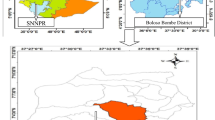Abstract
By means of a cluster analysis, we classified 135 relevés of the forests of the Muniellos Reserve into 8 groups and the species in these relevés into 28 groups. The concentration analysis applied allows to study the relationship between relevé group and species group. The forest types in Muniellos Reserve are: mixed riverside forest, mixed forest with hazel, semideciduous pyrenean oak forest, xerophilous and mesophilous sessile oak forest, beech forest and open and thick birch forest. These forest types are characterized floristically, structurally and ecologically. The pattern of distribution of forest types in the Muniellos Reserve is also discussed; in the siliceous areas of the Orocantabric province this pattern is widespread, but differes to some extent from the accepted pattern.
Similar content being viewed by others
References
Amigo, J., Guitían, J. & Fernández-Prieto, J. A. 1987. Datos sobre los bosques ribereños de aliso (Alnus glutinosa) cántabro-atlánticos ibéricos. Secretariado de publicaciones de la Universidad de La Laguna (Tenerife), Ser. Informes 22: 159–176.
Braun-Blanquet, J. 1979. Fitosociología. Edit. Blume. Madrid.
Castroviejo, S. 1973. Notas preliminares sobre la vegetación del tramo occidental de la Cordillera Cantábrica (Sierra de los Ancares). Asturnatura 1: 59–70.
Feoli, E. & Orlóci, L. 1979. Analysis of concentration and detection of underlying factors in structured tables. Vegetatio 40: 49–54.
Fernández-Prieto, J. A. & Vázquez, V. M. 1987. Datos sobre los bosques asturianos orocantábricos occidentales. Lazaroa 7: 363–382.
García-González, A. & Goldsmith, F. B. 1988. Cantabrian mountain Beechwoods: A Survey and the Case for their Conservation. Biological Conservation 45: 121–134.
Greig-Smith, P. 1983. Quantitative Plant Ecology. Blackwell Scientific publications. Oxford.
Izco, J. Amigo, J. & Guitián, J. 1986. Identificación y descripción de los bosques montanos del extremo occidental de la Cordillera Cantábrica. Trabajos Compostelanos de Biología 13: 183–202.
López-Pacheco, M. J. 1988. Flora y vegetación de las cuencas alta y media del Rio Curueño (León). Diputación Provincial de León, Institución Fray Bernardino de Sahagún. León.
Mayor, M. & Díaz, T. E. 1977. La Flora Asturiana. Ayalga Ediciones. Salinas, Asturias.
Navarro-Andrés, F. 1974. La vegetación de la Sierra del Aramo y sus estribaciones (Asturias). Rev. Fac. Cienc. Oviedo 15: 111–243.
Orlóci, L. 1975. Multivariate analysis in vegetation research. Junk, The Hague.
Orlóci, L. 1988. Community organization: recent advances in numerical methods. Can. J. Bot. 66: 2626–2633.
Peinado-Lorca, M. & Rivas-Martínez, S. (Edit.). 1987. La Vegetación de España. Servicio de Publicaciones de la Universidad de Alcalá de Henares. Madrid.
Pérez-Morales, C. 1988. Flora y vegetación de la cuenca alta del Rio Bernesga. Diputación Provincial de León, Institución Fray Bernardino de Sahagún. León.
Puente-García, E. 1988. Flora y vegetación de la cuenca alta del Rio Sil (León). Diputación Provincial de León, Institución Fray Bernardino de Sahagún. León.
Rivas-Martínez, S. 1962. Contribución al estudio fitosociológico de los hayedos españoles. Anales Inst. Bot. Cavanilles 20: 90–128.
Rivas-Martínez, S. 1964. Esquema de la vegetación potencial y su correspondencia con los suelos en la España Peninsular. Anales Inst. Bot. Cavanilles 22: 341–405.
Rivas-Martínez, S., Izco, J. & Costa, M. 1971. Sobre la flora y vegetación del Macizo de Peña Ubiña. Trab. Det. Botánica y F. Veg. Univ. Complutense 3: 47–123.
Rivas-Martínez, S., Díaz, T. E., Fernández-Prieto, J. A., Loidi, J. & Penas, A. 1984. La vegetación de la Alta Montaña Cantábrica. Los Picos de Europa. Ediciones Leonesas. León.
Rivas-Martínez, S., Bandullo, J. M., Allue, J. L., Montero de Burgos, J. L. & González-Rebollar, J. L. 1987. Memoria del Mapa de Series de Vegetación de España. I.C.O.N.A. Madrid.
Romero, C. M. 1983. Flora y vegetación de la cuenca alta del Rio Luna (León). I.C.O.N.A., Ministerio de Agricultura, Pesca y Alimentación. Monografía 29. Madrid.
Tutin, T. G., Heywood, V. H., Burges, M. A., Moore, D. M., Valentine, D. H., Walters, S. M. & Webb, D. A. (Edis). 1964–1980. Flora Europaea. 5 Vol. Cambridge University Press.
Wildi, O. & Orlóci, L. 1983. Management and multivariate analysis of vegetation data. Swiss Federal Institute of Forestry Research. Birmensdorf.
Wildi, O. & Orlóci, L. 1988. MULVA-4 a package for multivariante analysis of vegetation data. Version 3–88. Handbook for use of programs. Swiss Federal Institute of Forestry Research. Birmensdorf.
Wildi, O. & Orlóci, L. 1990. Numerical exploration of community patterns. SPB Academic Publishing. The Hague.
Author information
Authors and Affiliations
Rights and permissions
About this article
Cite this article
Prieto, J.A.F., Sánchez, A.B. A new classification of the forests of the Muniellos Biological Reserve in Northwest Spain. Vegetatio 102, 33–46 (1992). https://doi.org/10.1007/BF00031702
Accepted:
Issue Date:
DOI: https://doi.org/10.1007/BF00031702



